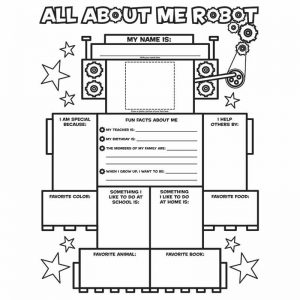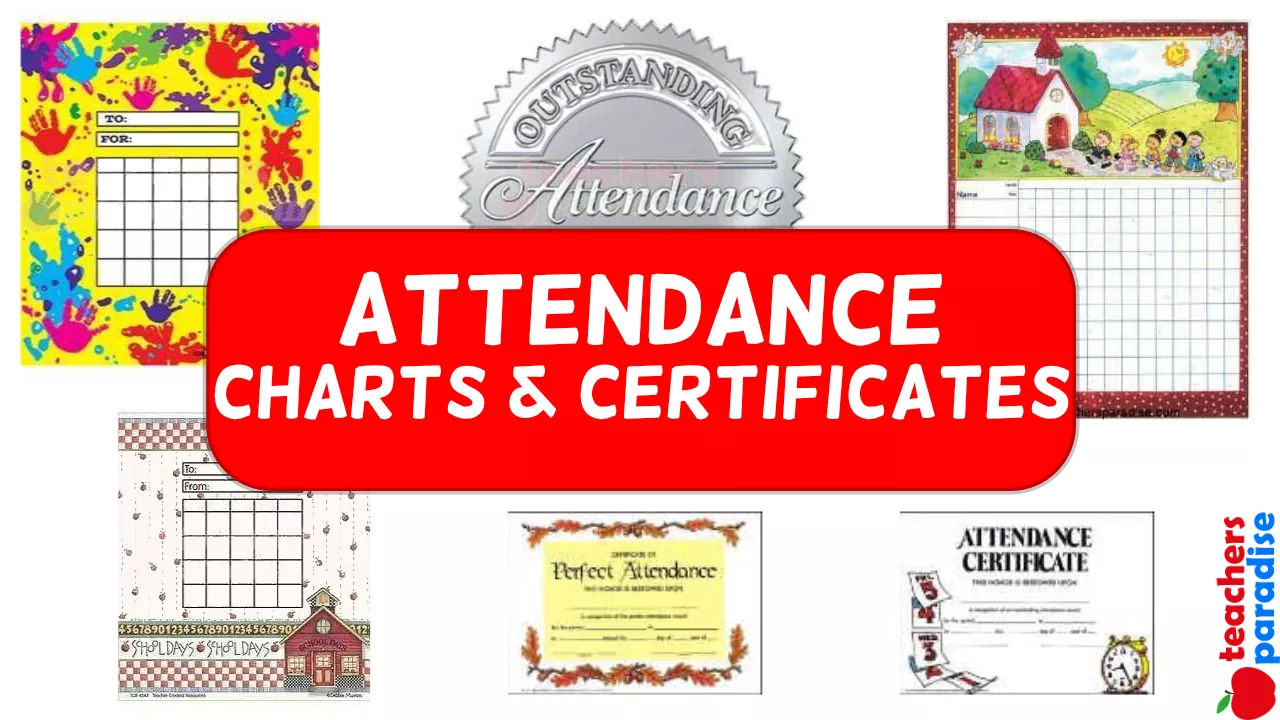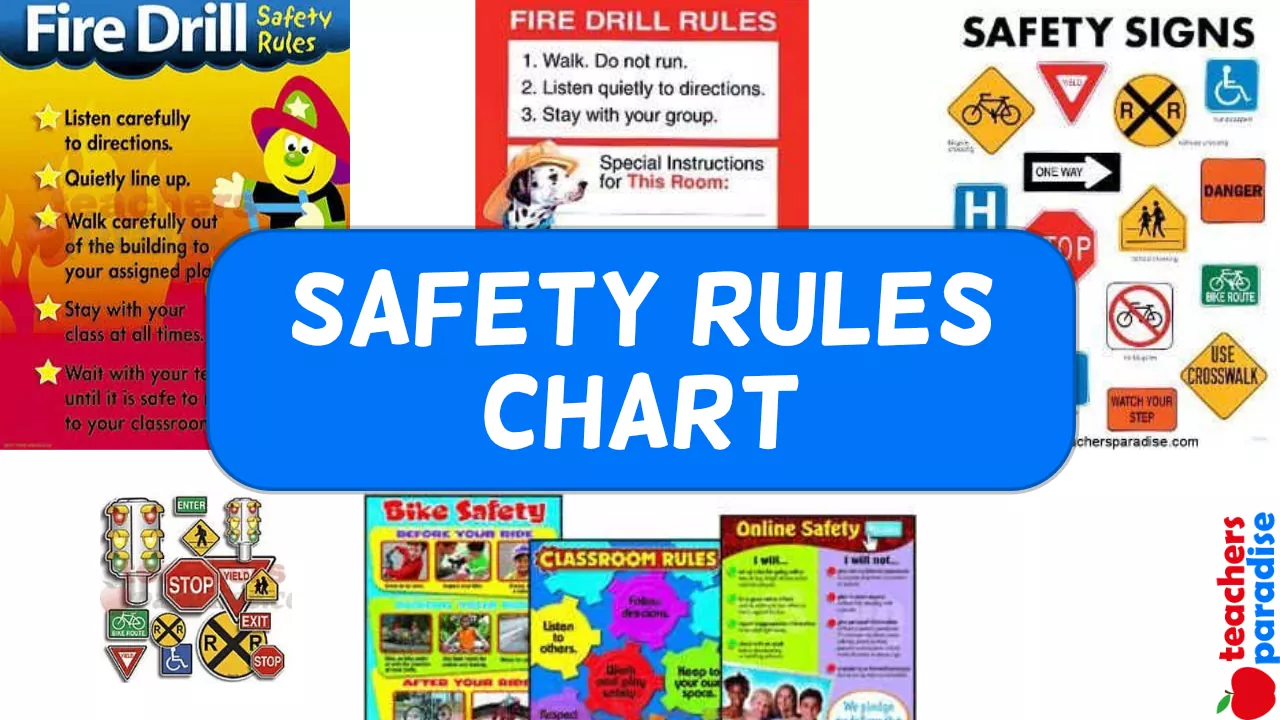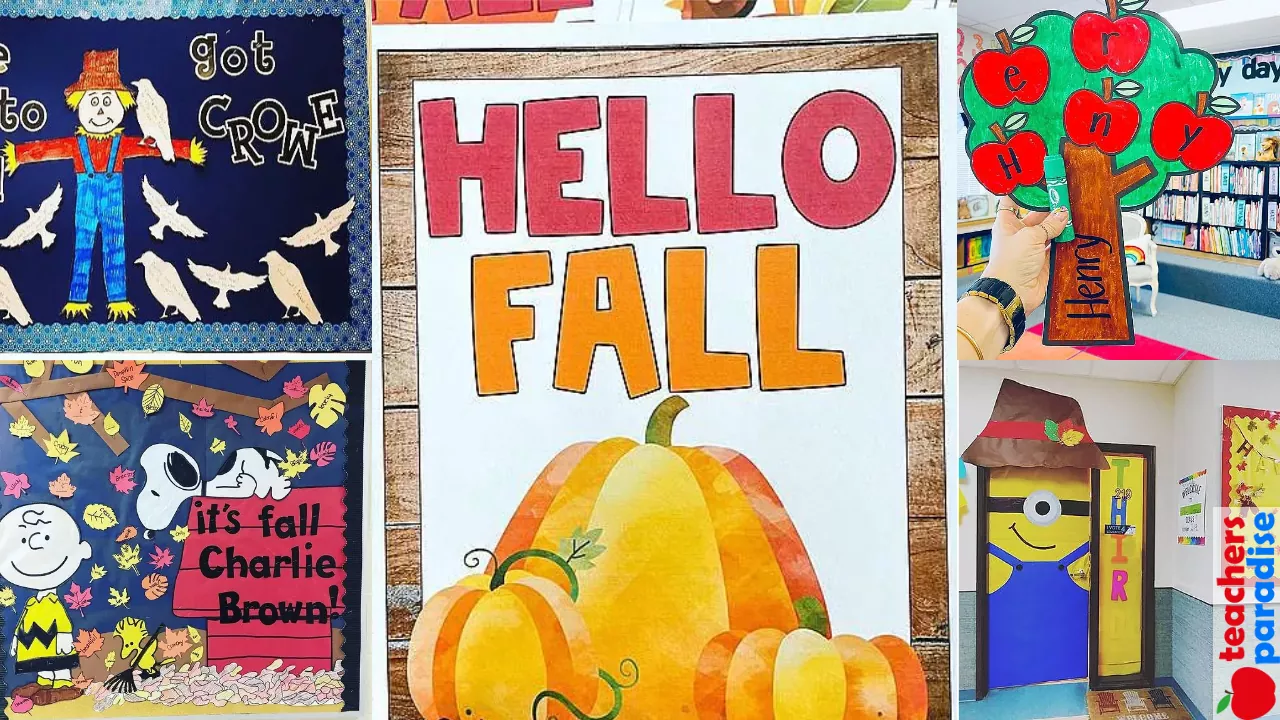Will the Real Sacagawea Please Stand Up?
- Note that, in other sources you may see Sacagawea’s name spelled Sacajawea or Sakakawea. However, this is now the accepted spelling.
Host: Welcome to To Tell the Truth! Today’s guest is Sacagawea (pronounced Sah-cawga-WAY-ah), the Shoshone Indian guide who traveled with Lewis and Clark on their expedition west of the Mississippi. Of course, only one of our three guests is the real Sacagawea. The other two are impostors. Listen carefully to what each one says. Then it’s up to you to figure out who’s telling the truth, the whole truth, and nothing but the truth. Let’s begin by meeting our guests.
Characters
Host
Biographer 1
Biographer 2
Biographer 3
Sacagawea 1
Sacagawea 2
Sacagawea 3
Panelist 1
Panelist 2
Panelist 3
Panelist 4
Panelist 5
WORKSHEET & Sample PDF Activity
Sample PDF Activity
Biographer 1: Before we start, the real Sacagawea has asked us to read this letter of introduction to you:
Dear Students: I, Sacagawea, was born around 1787 in the area now called “Idaho,” in the Rocky Mountains. There were only thirteen states and about four million people in the country then. A few years later, in 1804, Thomas Jefferson hired Meriwether Lewis and Captain William Clark to find a direct water route west to the Pacific Ocean. At about the same time, the United States signed the Louisiana Purchase agreement with France. This purchase expanded this country’s borders. It also calmed any fears that France would try to build an empire on American soil.
Biographer 2: (continues reading the letter)
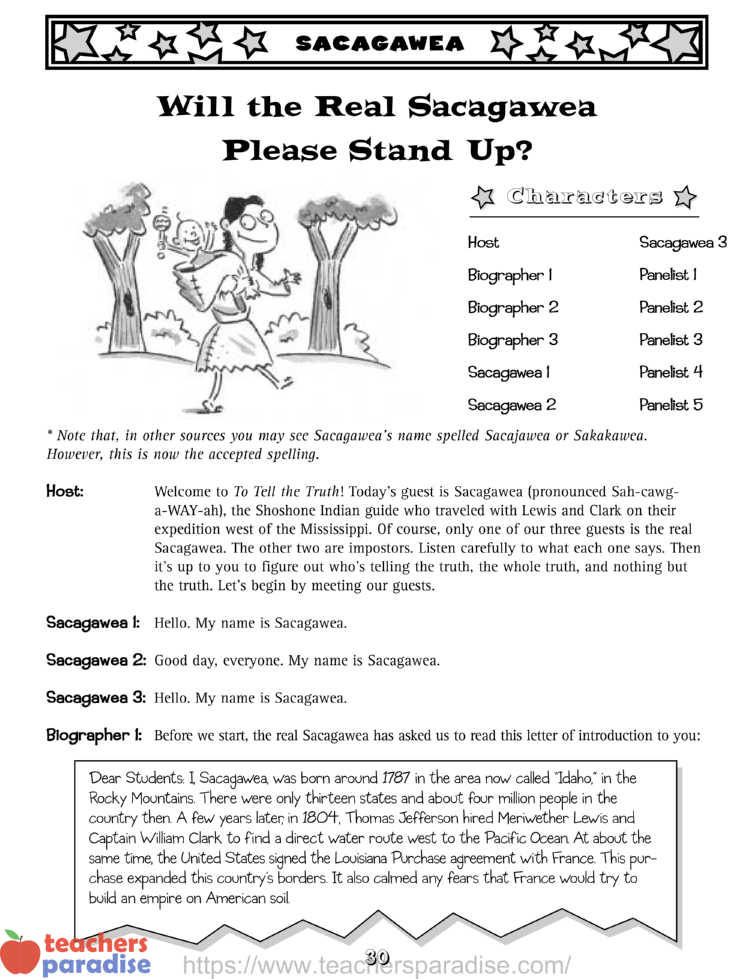
Lewis and Clark hired my husband, a French Canadian trader named Touissant Charbonneau as an interpreter. He asked if I could come along. Lewis and Clark liked the idea—especially since I spoke several Native languages. Besides, we’d be traveling through Shoshone country, where I was born. And, as a Native woman with an infant, I would be a sign to tribe leaders that our expedition had come in peace.
Biographer 3: (continues reading the letter)
There are very few records about what happened to me after the expedition. Some say I died in my twenties from a fever. Others say that I lived to be almost one hundred years old. No one knows for sure. All around this country, mountain peaks, creeks, lakes, a mountain pass, and monuments are named for me. I am even honored on a U.S. dollar coin. It is said that no other American woman has as many memorials dedicated to her as I do. Signed, Sacagawea.
Host: Let’s begin the questioning with Panelist 1.
Panelist 1: In winter, your people, the Shoshone, lived in tepees on a high plateau in the Rocky Mountains. Then, in spring, the tribe would travel the Great Plains in search of buffalo. They were constantly at battle with another tribe, called the Minnetarees. Tell us some stories about your childhood with your tribe.
Sacagawea 1: First of all, I did not get the name Sacagawea until I was older and had been separated from my tribe. Actually, because of Shoshone traditions, I probably had several different names while I was growing up.
Sacagawea 2: As a girl, my mother would have me watch my baby brother. One day, I placed him in his cradle board, and set it down near the river. But a dog accidentally knocked the cradle board into the water—with my brother in it! Before the currents could carry him downstream, I jumped in and grabbed him. We were both rescued, but it was a close call!
Sacagawea 3: One time my grandmother and I were out looking for firewood in a rocky area. Suddenly, she fell and injured her leg. Just then, a rattlesnake came out from among the rocks and moved toward her. I could see that she was having trouble getting up, so I grabbed a stone and threw it at the snake’s head. Then I used my knife to jab it a few times until it was dead.
Panelist 2: When you were about twelve years old, you were captured by the Minnetarees. They’re the ones who gave you the name that we know you by today. Tell us something else about your life with them.
Sacagawea 1: Unlike the Shoshone, the Minnetarees were farmers. While living with them, I learned how to hoe the earth and plant seeds for crops like maize, which you call “corn.” I also learned other skills, like how to make robes out of buffalo skins and moccasins from the hides of antelope and deer.
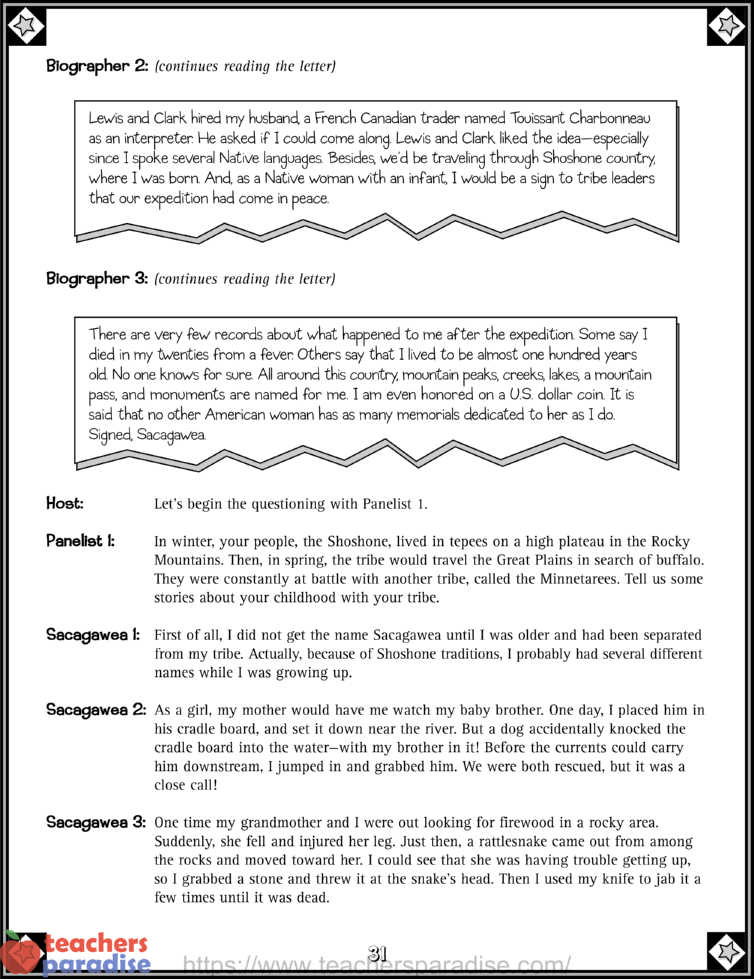
Sacagawea 2: More than once, I thought about running away and trying to return to my people. But it would have been a long journey. We traveled about five hundred miles or so after the Minnetarees captured me. I didn’t even know if anyone else in my family had survived their raid. So, even though I once had a chance to escape with two other girls from my tribe, I decided to stay behind.
Sacagawea 3: When I was about fifteen years old, a French Canadian trader named Toussaint Charbonneau came to our Minnetaree village and won me in a gambling game. That’s how I became his wife.
Panelist 3: Right about the same time that you met Charbonneau, Lewis and Clark were setting out on their expedition. But to cross the Rocky Mountains, they knew they would need horses, supplies, and experienced people like you to help. That’s why, even though you had a newborn baby at the time, they allowed you to come along. Tell us, what did you do on the expedition?
Sacagawea 1: On the journey, we faced sickness, hunger, terrible winter months, mosquitoes, and grizzly bears. But on the way, I proved very helpful. I cooked, mended clothes, made hundreds of moccasins for the men, and cared for the sick. I also found roots and berries for us to eat when food was scarce.
Sacagawea 2: Though the men had thought to bring a medicine chest on the trip, there was no doctor. Luckily, my mother and grandmother had taught me how to use herbs and remedies to make people well.
Sacagawea 3: Once, as we were sailing down a river in bad weather, our boat almost capsized. While the others worked to prevent the boat from sinking, I reached over the side and rescued many papers, instruments, and medical supplies that had fallen out. Without these things, we might have had to turn back. In any case, all records of what we’d seen so far would have been lost!
Panelist 4: As you traveled, you started to recognize landmarks and other familiar sights from your childhood. It crossed your mind that you might even see your own people, the Shoshone, on the trip. Then Lewis and Clark brought you, as their interpreter, to a tribe leader. When you realized it was your brother, you were overcome with joy! What did you do then?
Sacagawea 1: What would you have done if you had been kidnapped, made a slave, and then forced to marry a man three times older than you were? I didn’t have to think twice! I stayed with the Shoshone.
Sacagawea 2: At first, I didn’t think my husband would let me stay. But my brother, as the head of our tribe, agreed to pay a high price for me. So, as it turned out, I was bought back by my people.
Sacagawea 3: This was a hard decision for me. But in the end I decided to continue the journey with the white men. I was curious to see the “great water where the sun set,” known as the “Pacific Ocean.” Besides, the expedition really seemed to need my help.
Panelist 5: In 1906, when the Lewis and Clark expedition ended, your husband received $500.33 from the U.S. government for his services. What did you get?
Sacagawea 1: Because I stayed with the Shoshone, I was told that I didn’t deserve a thing.
Sacagawea 2: I was awarded the exact same amount of money as my husband. After all, that was only fair.
Sacagawea 3: I received no money from the government, as they saw me as nothing more than Charbonneau’s wife. But Captain Clark, who had become very attached to my son, Jean Baptiste, offered to pay for his education, which he later did. My son was thus raised as a white man, and later became the mayor of San Luis Rey, California.
Host: Okay, everyone. It is now time to decide who you think is the real Sacagawea. With a show of hands, how many think it is Sacagawea 1? (pause) Sacagawea 2? (pause) Sacagawea 3? (pause) Now that everyone has voted, let’s have the real Sacagawea please stand up.
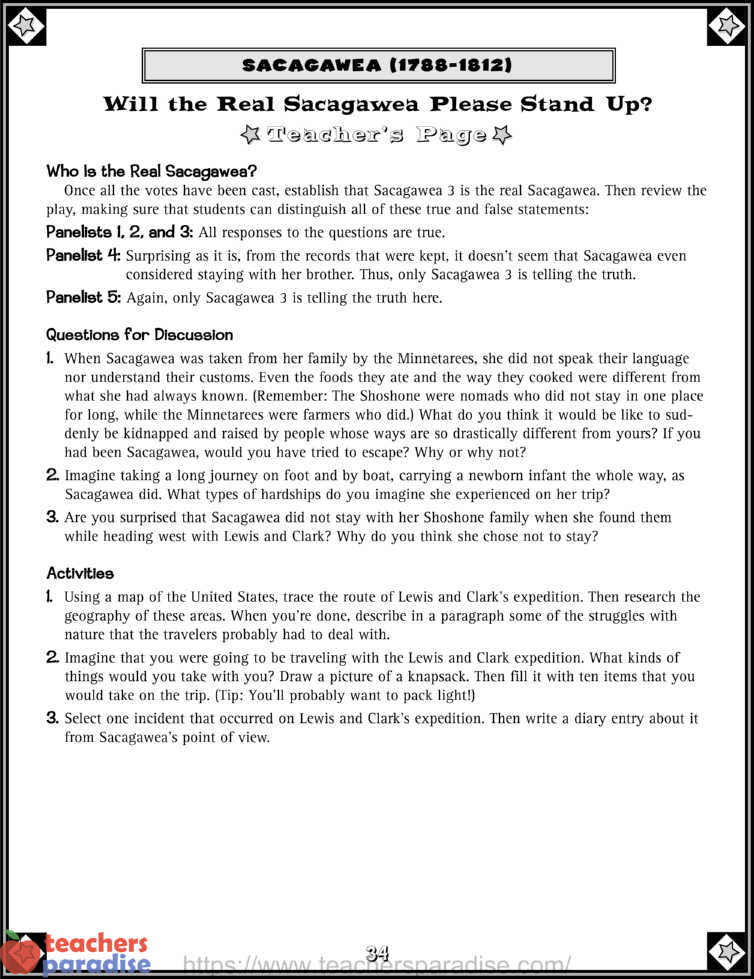
Sacagawea (1788–1812)
Will the Real Sacagawea Please Stand Up? – Teacher’s Page
Who Is the Real Sacagawea?
Once all the votes have been cast, establish that Sacagawea 3 is the real Sacagawea. Then review the play, making sure that students can distinguish all of these true and false statements:
Panelists 1, 2, and 3: All responses to the questions are true.
Panelist 4: Surprising as it is, from the records that were kept, it doesn’t seem that Sacagawea even
considered staying with her brother. Thus, only Sacagawea 3 is telling the truth.
Panelist 5: Again, only Sacagawea 3 is telling the truth here.
Questions for Discussion
- When Sacagawea was taken from her family by the Minnetarees, she did not speak their language nor understand their customs. Even the foods they ate and the way they cooked were different from what she had always known. (Remember: The Shoshone were nomads who did not stay in one place for long, while the Minnetarees were farmers who did.) What do you think it would be like to suddenly be kidnapped and raised by people whose ways are so drastically different from yours? If you had been Sacagawea, would you have tried to escape? Why or why not?
- Imagine taking a long journey on foot and by boat, carrying a newborn infant the whole way, as Sacagawea did. What types of hardships do you imagine she experienced on her trip?
- Are you surprised that Sacagawea did not stay with her Shoshone family when she found them while heading west with Lewis and Clark? Why do you think she chose not to stay?
Activities
- Using a map of the United States, trace the route of Lewis and Clark’s expedition. Then research the geography of these areas. When you’re done, describe in a paragraph some of the struggles with nature that the travelers probably had to deal with.
- Imagine that you were going to be traveling with the Lewis and Clark expedition. What kinds of things would you take with you? Draw a picture of a knapsack. Then fill it with ten items that you would take on the trip. (Tip: You’ll probably want to pack light!)
- Select one incident that occurred on Lewis and Clark’s expedition. Then write a diary entry about it from Sacagawea’s point of view.


